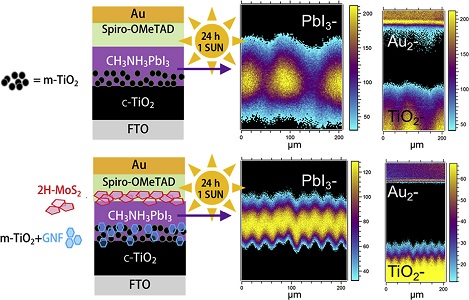
ABSTRACT
The stability of perovskite solar cells (PSCs) is a major factor limiting the market breakthrough of this technology. To understand the aging effects in PSCs is mandatory to rationally design implemented architectures and materials combining a viable deposition process, efficiency and stability. Despite of this evidence, only few experimental works succeeded in the direct quantitative characterization of aging effects in PSCs. In this work, we apply state-of-the-art X-ray photoelectron spectroscopy (XPS) depth profile analysis and time-of-flight secondary ion mass spectrometry (ToF-SIMS) 3D imaging to investigate the light-induced degradation of layers and interfaces in reference (Au/Spiro-OMeTAD/CH3NH3PbI3/m-TiO2/cTiO2/FTO) and interface-engineered mesoscopic PSCs in which graphene flakes are added into the mesoscopic TiO2 layer and a solution-processed 2H-MoS2 flakes buffer layer is added at the Spiro-OMeTAD/CH3NH3PbI3interface. Results show that the graphene addition into the mesoscopic TiO2 layer improves the stability of the PSC by reducing the locally-inhomogeneous light-induced back-conversion of the CH3NH3PbI3 layer into PbIx and PbOx species and the consequent release of iodine species, which diffuse across the interfaces and causes the modifications at the gold electrode (Au-I bonding) and the mesoscopic TiO2 (Ti-I bonding) interfaces. Moreover, where the CH3NH3PbI3 layer is preserved the gold diffusion across the entire device structure is strongly reduced even after the aging. The 2H-MoS2 flakes buffer layer allows limiting the localized diffusion of gold and the iodine diffusion in as-prepared PSCs while it is rather ineffective in preventing light-induced aging effects. Overall, thanks to the lower average degradation of the layers and interfaces, interface engineered PSCs could retain ∼60% of their initial PCE after the aging respect to less than ∼25% in the reference cells.
Yan Busby, Antonio Agresti, Sara Pescetelli, Aldo Di Carlo, Celine Noel, Jean-Jacques Pireaux, Laurent Houssiau
DOI: 10.1016/j.mtener.2018.04.005
https://www.sciencedirect.com/science/article/pii/S2468606918300303





